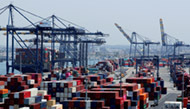[한글번역]Controversial Canal Tests South Korea’s New Leader
Lee’s plan goes through, the craggy mountains where miners once dug for coal will offer a new source of income: tourists and freight barges sailing down a waterway blasted though the hills.
“The canal will bring prosperity back to our town,’’ said Min Byung-do, 44, a high school teacher here.
“It will put our town on the map.
People will start moving in.
They’ll no longer put us down as yokels.
’’ Mungyong lies midway along the proposed Grand Korean Waterway, a 540-kilometer canal that would cut diagonally across the country between Seoul and Pusan, South Korea’s two largest cities.
Mr.Lee, who took office in February, said he hoped to complete it during his five-year term.
The most challenging engineering work will take place around Mungyong.
Once the project is completed, engineers say, freight barges and tourist boats either will be lifted through the mountains on a skyway of locks and lifts, or cruise underground through a 21-kilometer tunnel.
The goal is to connect the Nakdong River, which flows into the Korea Strait at Pusan, the country’s largest port, in the southeast, and the Han River, which runs through Seoul and joins the Yellow Sea in the northwest.
Whether Mr.Lee can sell the canal idea will be the first major test of his leadership.
So sharp is the debate on the canal that supporters and critics hardly seem to be talking about the same project.
Mr.Lee said it would create 300,000 jobs and revitalize moribund inland economies.
He said that the volume of industrial cargo would double by 2020, and that a canal would provide cleaner and cheaper, if slower, transport .
But there are plenty of detractors, including the political opposition and environmental groups At an anti-canal forum in February organized by 80 professors at Seoul National University, speakers said Mr.
Lee’s project had little value.
One speaker, Hong Jong-ho, an economist at Hanyang University, said the canal would create an “environmental disaster’’ that would worsen flooding and pollute the two rivers that supply drinking water for two-thirds of the nation’s 49 million people.
He also said the waterway would cost as much as $50 billion.
Mr.Lee has estimated the cost at $16 billion.
Meanwhile, canal fever is sweeping towns along the rivers.
“If you oppose the canal, you are not one of us,’’ reads a banner in Yoju, a town south of Seoul.
A sign posted by a real estate broker advertises a plot “only five minutes from the canal.
’’ “Our town suffered many restrictions on land development because the central government wanted to protect the water quality of the Han River,’’ said Chung Jong-sop, 54, a Yoju farmer.
“If the canal comes, it will put an end to those restrictions and bring development to our town.
’’ Mungyong, a mountain-locked town, is festooned with signs welcoming the canal.
Banners show views of a future Mungyong as a thriving inland harbor .
“Until now, we saw no future, no way to turn around our economy,’’ said Baek Youngja, 43, a restaurateur in Mungyong.
“Talk about possible environmental damage the canal might cause doesn’t mean that much to me.
I think more about all the engineers who will come in and eat at my place once construction starts.’’
새 한국 지도자 시험하는 운하
<한국, 문경에서 최상훈 기자>
이명박 대통령이 이 나라에서 가장 야심차고, 가장 말많은 건설 계획 추진에 착수할 때까지 한때 번창하던 탄광마을이었던 문경은 이곳을 관통하는, 잡초가 무성한 녹슨 철로처럼 한국의 경제 성장에서 뒤처져 있었다.
이 대통령의 계획이 실행된다면 광부들이 석탄을 캐던 이곳의 울퉁불퉁한 산들은 새로운 수입원이 된다. 물길로 관광객들과 화물을 실어 나를 바지선들이 굉음을 내며 산속을 통과할 것이기 때문이다. “우리 마을이 운하 덕분에 다시 번창할 것입니다. 지도에 마을 이름이 올라가면 사람들이 다시 살러 들어올 것이고, 우리를 촌놈이라고 멸시하지도 않겠죠” 여기서 고교 교사로 일하는 민병도(44)씨의 말이다.
문경은 한국의 양대도시인 서울과 부산 사이를 대각선으로 잇는 전장 540킬로미터인 한반도대운하의 중간 지점에 위치한다. 지난 2월 취임한 이대통령은 5년인 자신의 임기 안에 완공하기를 희망하고 있는데 공학적으로 가장 어려운 작업이 바로 문경 주변에서 이루어질 예정이다. 완성 되면 화물선과 관광선은 산맥들 사이로 들어 올려지거나 21킬로미터의 지하 터널을 거쳐 이곳을 통과하게 될 것이라고 엔지니어들은 말하고 있다.
동남아에서 제일 큰 항구인 부산에서 대한해협으로 흘러 들어가는 낙동강과 서울을 관통하여 서북쪽의 황해로 유입되는 한강을 연결시키는 것을 목적으로 하고 있는 이 운하 건설안의 관철 여부는 이 대통령의 지도력에 대한 커다란 첫 시험이다. 운하 건설 지지측과 반대측의 논란은 하도 첨예하게 대립해 양쪽이 같은 프로젝트에 관해 이야기하고 있는 것 같지 않을 정도다.
이대통령은 운하 건설로 30만개의 일자리가 창출되고 빈사상태인 내륙 경제가 활성화될 것이라면서 2020년께는 산업 화물의 용적이 2배로 증가할 것이고, 조금 느려질지언정 더 깨끗하고 저렴하게 운송 방법이 생긴다고 말한다.
그러나 정치적 반대 세력및 환경 단체를 포함, 중상하는 사람들도 많다. 서울대학교 교수 80명이 조직한 운하 건설 반대 공개토론회에서 발언자들은 가치없는 계획이라고 몰아붙였다. 그중 한사람인 한양대 경제학교수 홍종호씨는 운하가 건설되면 홍수가 더 심해지고 전국민 4900만명의 3분의 2의 식수원인 두 강이 오염될 것이며, 건설비 또한 이대통령측이 추산한 160억달러가 아닌 500억달러까지 들 것이라고 말했다.
그러는 사이에도 운하 건설의 열기는 강들을 따라 마을들을 휩쓸고 있다.
서울 남쪽에 있는 마을 여주에는 “운하에 반대하면 우리가 아니라 남”이라고 쓰인 현수막이 걸려있고 어떤 부동산 중개인은 “운하에서 단 5분거리”라고 땅을 선전하고 있다.
“중앙 정부의 한강 수질 보호 정책 때문에 우리 마을은 토지 개발에 많은 제한을 받아 왔는데 운하가 건설되면 그런 제한도 풀리고 개발도 될 것”이라고 여주에서 농사를 짓는 정종섭씨(54)는 기대에 차 있다.
산으로 막혀있는 마을인 문경에 줄줄이 매달린 운하를 환영하는 현수막들은 장래 문경의 모습을 번창하는 내륙의 항구로 그리고 있다. “지금까지는 미래도, 경기를 살릴 방법이 없었어요. 운하의 환경 파괴 가능성 같은 이야기는 나한텐 별 의미가 없어요. 공사가 시작되면 우리 집에 와서 먹을 그 모든 인부들에 대한 생각이 더 많지” 문경에서 식당을 하는 백영자씨(43)의 말이다.
left behind 밀리다, 뒤떨어지다, 버림받다
goes through 통과하다, 전 과정을 마치다
Craggy 바위가 많은, 바위가 울퉁불퉁한
Barges 바지선, 바닥이 평평한 짐배, 의식용 호화 유람객선
Yokels (경멸조)시골뜨기
Diagonally 대각선으로, 사선으로
Yellow Sea 황해, 중국 동부 해안과 한반도 사이의 바다
Moribund 다 죽어가는, 빈사상태의
Lock (운하, 강의) 갑문, 수문
Lift 기중기, 리프트
skyway 고가식 고속도로
plenty of 많은
forum 공개토론
스마터리빙
more [ 건강]
[ 건강]이제 혈관 건강도 챙기자!
[현대해운]우리 눈에 보이지 않기 때문에 혈관 건강을 챙기는 것은 결코 쉽지 않은데요. 여러분은 혈관 건강을 유지하기 위해 어떤 노력을 하시나요?
 [ 건강]
[ 건강]내 몸이 건강해지는 과일궁합
 [ 라이프]
[ 라이프]벌레야 물럿거라! 천연 해충제 만들기
 [ 건강]
[ 건강]혈압 낮추는데 좋은 식품
[현대해운]혈관 건강은 주로 노화가 진행되면서 지켜야 할 문제라고 인식되어 왔습니다. 최근 생활 패턴과 식생활의 변화로 혈관의 노화 진행이 빨라지고
사람·사람들
more많이 본 기사
- 대법원 “최종심 나올 때까지 시카고에 주방위군 투입 안돼”
- 법무부, ‘반자동 소총 금지’ 워싱턴DC 상대 소송… “위헌”
- 美, 카리브해로 특수부대 전개…베네수 작전 개시 임박했나
- 델라웨어 차량등록국서 총격…州경찰관 1명 사망
- ‘헉’ 오바마케어 보험료가 연 4만불… 1
- “트럼프 행정부, 스페이스X에 동물보호구역 토지 양도 검토”
- 경찰, ‘통일교 로비 의혹’ 한학자·윤영호 오늘 2차 접견조사
- 트럼프, GDP 호조에도 “금리 내려야…동의못하면 연준의장 안돼”
- 박나래, 논란 또 추가..이번엔 ‘나혼산’ 조작 방송 의혹
- 조지아서 역주행 승용차 덮쳐 한인 등 2명 사망
- 법무부, 엡스타인 자료 추가 공개… “전용기에 트럼프 8번 타”
- 46회째 1등 안나온 파워볼 복권…당첨금 약 16억 달러로 껑충
- 中과 무역갈등 휴전한 美 “中반도체 추가관세 18개월간 보류”
- [새해 강화되는 노동법] 가주서 노동… 1
- 임윤아, 여우 주연상 쾌거.. “멋진 상 감사합니다”
- 2명에 모두 7,500달러 장학금
- 워너브러더스 주주 “파라마운트 인수안 여전히 불충분”
- “ATM기 사용하기 겁나네”
- ‘차량 링거’ 전현무 의료법 위반 고발당해… “적법한 진료” 해명
- 송성문, 메디컬테스트에 초긴장 “혹시 뭐 나올까 걱정했다→미국 열심히 갔는데 맨손으로 돌아올까봐”
- 이영지 맞아? 러블리 분위기 물씬..180도 달라진 ‘뼈말라’ 몸매
- ‘K-도넛’, 남가주 진출·본격 확장
- ‘트롯돌’ 손태진, 오디션 우승상금 7~8억?.. “무서워서 1년 넘게 안 썼다”
- 이번엔 ‘먹는 비만약’ 경쟁…알약 위고비, 미국서 판매 승인
- 트럼프 “국가안보 위해 그린란드 필요…우리가 가져야”
- “美국방부, 中격납고에 ICBM 100기이상 장전돼 있을것으로 판단”
- 美 경제 3분기 4.3% ‘깜짝 성장’…강한 소비가 성장견인
- 1,480원까지 돌파한 환율… “내년에도 고공 행진”
- 올해 워싱턴DC 식당 92곳 폐업…‘역대 최다’
- ICE 홈디포 급습 한인 체포
- ‘연방하원 도전장’ 척 박 예비후보 후원모임
- 에어프랑스 엔진 화재 5천피트 급강하 ‘아찔’
- 연말 여행객 최다… LAX 공항 ‘대혼잡’
- 21년간 장학금 총 60만 달러 지급
- 20%만 “트럼프 덕에 살림살이 나아졌다”
- ‘올해는 ICE 이민자 체포 광풍의 해’
- ‘거액 탈세·통관 사기’ 한인 통관브로커 중형
- ‘크리스마스 캐롤’과 산타 클로스 1
- 공정위, 대한항공 마일리지 통합안 보완명령
- 악명 높은 갱단 연루 한인 기소
- 양민혁·배준호 등 병역특례 기대감 커졌다, 日 자국 아시안게임도 ‘U-21’ 참가
- [정재민의 미디어풍경] 적과의 동침, 협력하며 경쟁하기
- 베네수엘라 봉쇄에 금·은 값 또 최고
- 4인 가족 보험료가 4만불까지… 중산층‘불안’
- 아마존, AI에이전트 출시 수요예측·재고관리 기능
- 한인 박찬영씨 교통시비 총격 사망...타코마중앙장로교회 40대 장로, 19일 레이시 도로서 참변
- AI로 가속화되는 노동시장 개편
- “불모지에 뿌린 한국어 씨앗”
- 美서 돌아온 푸틴 특사…러, 우크라 평화안 대응 촉각
- 엡스타인 파일서 지웠던 트럼프 사진 복원
1/5지식톡

-
 미 육군 사관학교 West Poin…
0
미 육군 사관학교 West Poin…
0https://youtu.be/SxD8cEhNV6Q연락처:wpkapca@gmail.comJohn Choi: 714-716-6414West Point 합격증을 받으셨나요?미 육군사관학교 West Point 학부모 모…
-
 ☝️해외에서도 가능한 한국어 선생님…
0
☝️해외에서도 가능한 한국어 선생님…
0이 영상 하나면 충분합니다!♥️상담신청문의♥️☝️ 문의 폭주로 '선착순 상담'만 진행합니다.☎️ : 02-6213-9094✨카카오톡ID : @GOODEDU77 (@골뱅이 꼭 붙여주셔야합니다…
-
 테슬라 자동차 시트커버 장착
0
테슬라 자동차 시트커버 장착
0테슬라 시트커버, 사놓고 아직 못 씌우셨죠?장착이 생각보다 쉽지 않습니다.20년 경력 전문가에게 맡기세요 — 깔끔하고 딱 맞게 장착해드립니다!장착비용:앞좌석: $40뒷좌석: $60앞·뒷좌석 …
-
 식당용 부탄가스
0
식당용 부탄가스
0식당용 부탄가스 홀세일 합니다 로스앤젤레스 다운타운 픽업 가능 안녕 하세요?강아지 & 고양이 모든 애완동물 / 반려동물 식품 & 모든 애완동물/반려동물 관련 제품들 전문적으로 홀세일/취급하는 회사 입니다 100% …
-
 ACSL 국제 컴퓨터 과학 대회, …
0
ACSL 국제 컴퓨터 과학 대회, …
0웹사이트 : www.eduspot.co.kr 카카오톡 상담하기 : https://pf.kakao.com/_BEQWxb블로그 : https://blog.naver.com/eduspotmain안녕하세요, 에듀스팟입니다…
케이타운 1번가
오피니언
 조환동 / 편집기획국장·경제부장
조환동 / 편집기획국장·경제부장 AI로 가속화되는 노동시장 개편
 민경훈 논설위원
민경훈 논설위원‘크리스마스 캐롤’과 산타 클로스
 정재민 KAIST 문술미래전략 대학원 교수
정재민 KAIST 문술미래전략 대학원 교수 [정재민의 미디어풍경] 적과의 동침, 협력하며 경쟁하기
 김영화 수필가
김영화 수필가 [화요칼럼] 단호박의 온기
 김정곤 / 서울경제 논설위원
김정곤 / 서울경제 논설위원[만화경] 안중근의사 유해봉환 사업
 권지숙
권지숙 오후에 피다
 옥세철 논설위원
옥세철 논설위원말살되고 있는 유럽의 성탄절 전통, 그 원인은…

외로운 이웃들
 조지 F·윌 워싱턴포스트 칼럼니스트
조지 F·윌 워싱턴포스트 칼럼니스트 [조지 F. 윌 칼럼] MIT에 대한 트럼프의 무분별한 공격
1/3지사별 뉴스

‘연방하원 도전장’ 척 박 예비후보 후원모임
연방하원에 도전장을 낸 척 박(한국명 박영철) 예비후보 후원 모임이 지난 18일 열렸다. 척 박의 부친인 박윤용 뉴욕주하원 25선거구 (민주)…
‘경찰 무력사용지침 갱신 의무화’ 입법 초읽기

‘올해는 ICE 이민자 체포 광풍의 해’
올 한해동안 버지니아와 메릴랜드, DC 등에서 연방 이민당국에 체포된 사람이 1만명이 훌쩍 넘는 것으로 조사됐다. 또 미 전국적으로는 22만명…
“ATM기 사용하기 겁나네”

연말 ‘로드레이지’ 비극… 한인 총격 피살
연말을 맞아 도로 위에서 순간적으로 벌어진 운전 중 시비가 40대 한인 가장의 총격 피살 비극으로 이어졌다. 워싱턴주 레이시 경찰국과 서스턴 …
엡스타인 파일 공개 다음날 트럼프 사진 삭제…야당서 탄핵 경고

오늘 하루 이 창 열지 않음 닫기 





















































.png)


댓글 안에 당신의 성숙함도 담아 주세요.
'오늘의 한마디'는 기사에 대하여 자신의 생각을 말하고 남의 생각을 들으며 서로 다양한 의견을 나누는 공간입니다. 그러나 간혹 불건전한 내용을 올리시는 분들이 계셔서 건전한 인터넷문화 정착을 위해 아래와 같은 운영원칙을 적용합니다.
자체 모니터링을 통해 아래에 해당하는 내용이 포함된 댓글이 발견되면 예고없이 삭제 조치를 하겠습니다.
불건전한 댓글을 올리거나, 이름에 비속어 및 상대방의 불쾌감을 주는 단어를 사용, 유명인 또는 특정 일반인을 사칭하는 경우 이용에 대한 차단 제재를 받을 수 있습니다. 차단될 경우, 일주일간 댓글을 달수 없게 됩니다.
명예훼손, 개인정보 유출, 욕설 등 법률에 위반되는 댓글은 관계 법령에 의거 민형사상 처벌을 받을 수 있으니 이용에 주의를 부탁드립니다.
Close
x